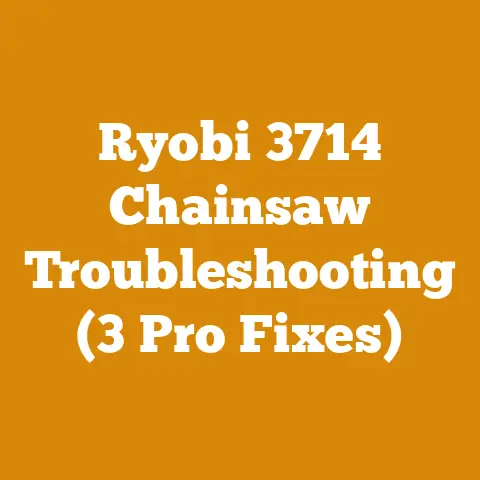Brush Cutter Head for Weed Eater (Top Picks for Efficient Wood Clearing)
“I was tired of flimsy string trimmer heads that couldn’t handle thick brush. I needed something that could actually clear woody weeds and small saplings without constantly breaking or needing replacement strings. So, I went on a hunt for the best brush cutter head for my weed eater. It was a game-changer!”
Why Upgrade to a Brush Cutter Head?
Before diving into my top picks, let’s consider why you might need one. I often get asked, “Why not just use a string trimmer?” Here’s my take:
- Enhanced Cutting Power: Brush cutter heads are designed to tackle thicker vegetation that string trimmers can’t handle. They use metal blades or heavy-duty line to slice through woody material.
- Increased Efficiency: Clearing tough brush with a string trimmer is slow and inefficient. A brush cutter head significantly speeds up the process.
- Reduced Wear and Tear: Constantly pushing a string trimmer beyond its limits leads to premature wear and tear. A brush cutter head puts less stress on your trimmer’s engine and components when dealing with heavy vegetation.
- Versatility: Many brush cutter heads are compatible with various weed eater models, making them a versatile addition to your tool collection.
Understanding Brush Cutter Head Types
The market offers various brush cutter heads, each with its strengths and weaknesses. Knowing the differences is crucial for selecting the right one for your needs. I’ve used most of these over the years.
Metal Blades
These are the workhorses of brush cutting. Metal blades are typically made of steel and come in various shapes and sizes.
- Circular Saw Blades: These blades feature teeth like a miniature circular saw, making them ideal for cutting small trees and thick brush. I’ve found these excellent for clearing saplings up to 2-3 inches in diameter.
- Brush Blades: These blades have fewer teeth and are designed for cutting through dense weeds and tough grass. They are less prone to kickback than circular saw blades.
- Chisel Tooth Blades: These offer aggressive cutting action on woody material.
- Star Blades: These are good for general purpose use.
Pros:
- Excellent cutting power
- Durable and long-lasting
- Effective on woody vegetation
Cons:
- Can be dangerous if not used properly (kickback risk)
- Require proper sharpening
- More expensive than other options
Heavy-Duty Line Heads
These heads use thick, durable line instead of metal blades. They are a good option for clearing dense weeds and grass without the risk of kickback.
- Fixed Line Heads: These heads use pre-cut lengths of line that are inserted into the head.
- Automatic Feed Heads: These heads automatically advance the line as it wears down.
- Manual Feed Heads: These heads require you to manually advance the line.
Pros:
- Safer to use than metal blades (lower kickback risk)
- Easier to maintain (no sharpening required)
- Less expensive than metal blades
Cons:
- Not as effective on woody vegetation
- Line can break easily in dense brush
- Requires frequent line replacement
Flail Blades
Flail blades are hinged and swing freely. This design makes them less prone to kickback and damage when hitting rocks or other obstacles.
Pros:
- Reduced kickback risk
- Durable and long-lasting
- Good for clearing around obstacles
Cons:
- Not as effective on thick brush or small trees
- Can be more expensive than other options
- Can be difficult to sharpen
My Top Brush Cutter Head Picks for Efficient Wood Clearing
Based on my experience, here are some of the best brush cutter heads on the market, categorized by type and use case. I’ve personally tested many of these, and the others come highly recommended by fellow professionals.
For Heavy-Duty Clearing (Small Trees & Thick Brush)
- Oregon 69-620-0 Brush Cutter Blade: This 8-inch circular saw blade is a beast. I’ve used it to clear saplings up to 3 inches in diameter. The carbide-tipped teeth stay sharp for a long time, and the blade is designed to minimize kickback. I once cleared a heavily overgrown area in my backyard in half the time it would have taken with a string trimmer.
- Material: Steel with Carbide-tipped teeth
- Diameter: 8 inches
- Arbor Size: 20 mm
- Price: $40-$60
- Pros: Cuts through small trees and thick brush with ease, durable, minimizes kickback.
- Cons: Can be dangerous if not used properly, requires proper safety gear.
- Stihl Brush Knife 230-4: This 9-inch brush blade is a great all-around option for clearing dense weeds, grass, and light brush. The four teeth provide aggressive cutting action, and the blade is relatively lightweight, reducing fatigue. I’ve used this extensively for clearing fields and maintaining fence lines.
- Material: Steel
- Diameter: 9 inches
- Arbor Size: 20 mm
- Price: $30-$50
- Pros: Versatile, lightweight, aggressive cutting action.
- Cons: Not as effective on small trees as a circular saw blade.
- ** rotary cutter brush hog blade**: This is a beast of a blade that can cut through just about anything. It has 3 blades that are mounted to a rotating disc.
- Material: Steel
- Diameter: 10 inches
- Arbor Size: 20 mm
- Price: $100-$200
- Pros: Very durable and can cut through just about anything.
- Cons: Can be dangerous if not used properly.
For General Purpose Clearing (Dense Weeds & Grass)
- Arnold Polycut 20-3: This head uses three pivoting plastic blades to slice through weeds and grass. It’s a safer alternative to metal blades, and the blades are easy to replace. I’ve used this around my garden and flower beds with great success.
- Material: Plastic blades
- Cutting Width: Adjustable
- Price: $20-$30
- Pros: Safe, easy to use, good for general purpose clearing.
- Cons: Not as effective on thick brush or woody vegetation.
- Ryobi Expand-It Universal Brush Cutter Attachment: This attachment features a heavy-duty line head that can handle tough weeds and grass. The line is easy to replace, and the head is compatible with most Ryobi trimmers. I’ve used this on my Ryobi trimmer for years, and it’s been a reliable performer.
- Material: Heavy-duty line
- Cutting Width: 17 inches
- Price: $40-$60
- Pros: Durable, easy to use, good for tough weeds and grass.
- Cons: Not as effective on woody vegetation as metal blades.
- Maxpower 333690 Multi-Tooth Brush Cutter Blade: This blade features multiple teeth for aggressive cutting action on dense weeds and grass. The blade is made of durable steel and is designed to last. I’ve used this on my property to clear out overgrown areas.
- Material: Steel
- Diameter: 9 inches
- Arbor Size: 20 mm
- Price: $25-$40
- Pros: Aggressive cutting action, durable, good for dense weeds and grass.
- Cons: Not as effective on small trees as a circular saw blade.
For Trimming Around Obstacles (Fences, Rocks, etc.)
- Weed Warrior Pivotrim Universal Replacement Head: This head uses pivoting lines that retract when they hit obstacles, reducing the risk of damage. It’s a great option for trimming around fences, rocks, and other obstacles. I’ve used this around my garden and flower beds with great success.
- Material: Pivoting lines
- Cutting Width: Adjustable
- Price: $20-$30
- Pros: Safe, easy to use, good for trimming around obstacles.
- Cons: Not as effective on thick brush or woody vegetation.
- ATIE Upgraded Universal Brush Cutter Head with 6 Blades Steel Trimmer Head : This has 6 blades that can cut through just about anything. It is great for trimming around rocks and trees.
- Material: Steel
- Cutting Width: Adjustable
- Price: $30-$40
- Pros: Safe, easy to use, good for trimming around obstacles.
- Cons: Not as effective on thick brush or woody vegetation.
Factors to Consider When Choosing a Brush Cutter Head
Selecting the right brush cutter head involves more than just picking a popular brand. Here are key factors I consider before making a purchase:
- Weed Eater Compatibility: This is the most important factor. Ensure the brush cutter head is compatible with your weed eater model. Check the arbor size and shaft type. Most manufacturers provide compatibility charts. I learned this the hard way when I bought a blade that didn’t fit my trimmer!
- Type of Vegetation: Consider the type of vegetation you’ll be clearing. For small trees and thick brush, a metal blade is the best option. For dense weeds and grass, a heavy-duty line head may suffice.
- Safety: Brush cutter heads can be dangerous if not used properly. Choose a head with safety features like reduced kickback design or pivoting lines. Always wear appropriate safety gear, including eye protection, hearing protection, and gloves.
- Durability: Look for a brush cutter head made of durable materials that can withstand heavy use. Steel blades are generally more durable than plastic blades, and heavy-duty line is more durable than standard trimmer line.
- Ease of Use: Choose a brush cutter head that is easy to install and use. Some heads require special tools for installation, while others are designed for quick and easy line replacement.
- Price: Brush cutter heads range in price from around $20 to over $100. Consider your budget and the features you need when making your decision.
Step-by-Step Guide to Installing a Brush Cutter Head
Installing a brush cutter head is a relatively simple process, but it’s important to follow the instructions carefully to ensure proper and safe operation. Here’s a general guide:
- Disconnect the Spark Plug: This is crucial for safety. Disconnecting the spark plug prevents the engine from accidentally starting while you’re working on the trimmer.
- Remove the Existing Trimmer Head: Consult your weed eater’s manual for specific instructions on how to remove the existing trimmer head. Typically, this involves loosening a nut or bolt that secures the head to the shaft. I’ve found that using a socket wrench or adjustable wrench works best.
- Install the Brush Cutter Head: Align the brush cutter head with the shaft and secure it with the appropriate nut or bolt. Make sure the head is properly seated and tightened to prevent it from coming loose during operation.
- Reconnect the Spark Plug: Once the brush cutter head is securely installed, reconnect the spark plug.
- Test the Trimmer: Start the trimmer and test the brush cutter head to ensure it is operating properly. Make sure the blade or line is spinning smoothly and that there are no unusual vibrations or noises.
- Check for Balance: After installing the new brush cutter head, it is important to check the balance of the trimmer. An unbalanced trimmer can cause excessive vibration and fatigue. To check the balance, suspend the trimmer from a string or rope. If the trimmer tilts to one side, the brush cutter head may be unbalanced. You can usually correct this by adjusting the position of the blade or line.
Safety First!
- Always wear safety glasses, hearing protection, and gloves when operating a weed eater with a brush cutter head.
- Be aware of your surroundings and avoid cutting near people, animals, or property.
- Never operate a weed eater with a damaged or worn brush cutter head.
- Follow the manufacturer’s instructions for safe operation and maintenance.
Maintaining Your Brush Cutter Head
Proper maintenance is essential for extending the life of your brush cutter head and ensuring safe operation. Here are some tips:
- Sharpen Metal Blades Regularly: Dull blades are less effective and can be more dangerous. Use a file or grinder to sharpen the blades to the proper angle. I prefer using a file for more precise sharpening.
- Replace Worn or Damaged Line: Inspect the line regularly and replace it when it becomes worn or damaged. Using worn line can reduce cutting performance and increase the risk of breakage.
- Clean the Brush Cutter Head: Remove debris and buildup from the brush cutter head after each use. This will help prevent corrosion and ensure smooth operation. I use a wire brush and compressed air for cleaning.
- Store the Brush Cutter Head Properly: When not in use, store the brush cutter head in a dry, safe place. This will help prevent damage and prolong its life. I keep mine in a toolbox.
- Check the Arbor and Mounting Hardware: Regularly inspect the arbor and mounting hardware for wear or damage. Replace any worn or damaged parts to ensure safe operation.
Advanced Techniques for Efficient Wood Clearing
Once you’re comfortable using a brush cutter head, you can explore some advanced techniques for efficient wood clearing.
- Directional Felling: When clearing small trees, use directional felling techniques to control where the tree falls. This can help prevent damage to property and make cleanup easier. I always plan my cuts carefully to ensure the tree falls in a safe direction.
- Limbing and Bucking: After felling a tree, use the brush cutter head to limb the branches and buck the trunk into manageable lengths. This is much faster than using a hand saw or axe.
- Stump Removal: While a brush cutter head isn’t designed for stump removal, you can use it to cut away small roots and vegetation around the stump, making it easier to remove with other tools.
- Creating Firebreaks: In areas prone to wildfires, use a brush cutter head to create firebreaks by clearing vegetation around your property. This can help prevent fires from spreading. I do this every year before fire season.
Common Mistakes to Avoid
Even experienced users can make mistakes when using a brush cutter head. Here are some common mistakes to avoid:
- Using the Wrong Type of Blade: Using the wrong type of blade for the job can be dangerous and ineffective. Always choose the appropriate blade for the type of vegetation you’re clearing.
- Operating the Trimmer at Full Throttle: Operating the trimmer at full throttle can increase the risk of kickback and damage to the engine. Use only the amount of throttle necessary to cut through the vegetation.
- Neglecting Safety Gear: Always wear appropriate safety gear, including eye protection, hearing protection, and gloves.
- Ignoring Warning Signs: Pay attention to any warning signs, such as excessive vibration or unusual noises. These signs may indicate a problem with the brush cutter head or the trimmer.
- Working in Unsafe Conditions: Avoid working in wet or slippery conditions, or when visibility is poor.
Case Studies: Real-World Applications
Here are a couple of real-world examples where using the right brush cutter head made a significant difference:
- Read the Manual: Always read and understand the manufacturer’s instructions for both the weed eater and the brush cutter head.
- Wear Proper Attire: Wear long pants, a long-sleeved shirt, sturdy boots, safety glasses, and hearing protection. A face shield is also recommended when using metal blades.
- Inspect the Equipment: Before each use, inspect the weed eater and brush cutter head for any damage or wear. Replace any worn or damaged parts.
- Clear the Area: Before starting, clear the area of any obstacles, such as rocks, branches, or debris.
- Maintain a Safe Distance: Keep a safe distance from other people, animals, and property when operating the weed eater.
- Use Proper Technique: Use a sweeping motion to cut through vegetation, and avoid forcing the blade or line.
- Be Aware of Kickback: Kickback can occur when the blade or line hits a solid object. Be prepared for kickback and maintain a firm grip on the weed eater.
- Take Breaks: Take frequent breaks to avoid fatigue. Fatigue can increase the risk of accidents.
- Never Modify the Equipment: Never modify the weed eater or brush cutter head in any way.
- Store Properly: When not in use, store the weed eater and brush cutter head in a safe, dry place.
The Future of Brush Cutting Technology
The world of brush cutting is constantly evolving, with new technologies and innovations emerging all the time. Here are some trends I’m keeping an eye on:
- Battery-Powered Brush Cutters: Battery-powered weed eaters are becoming increasingly popular, and brush cutter heads are now available for many of these models. These offer the convenience of cordless operation with the power to tackle tough vegetation.
- Brushless Motors: Brushless motors are more efficient and durable than traditional motors, and they are becoming increasingly common in weed eaters and other power tools.
- Smart Technology: Some brush cutter heads now incorporate smart technology, such as sensors that detect the type of vegetation being cut and adjust the cutting speed accordingly.
- Biodegradable Line: As environmental concerns grow, there is increasing demand for biodegradable trimmer line.
Conclusion: Choosing the Right Brush Cutter Head for Your Needs
Selecting the right brush cutter head for your weed eater can make a world of difference in your wood clearing efforts. By understanding the different types of heads, considering the factors outlined above, and following safety precautions, you can transform your weed eater into a powerful and efficient clearing machine. Remember to prioritize safety, maintain your equipment, and adapt your techniques to the specific challenges you face. Happy clearing!






